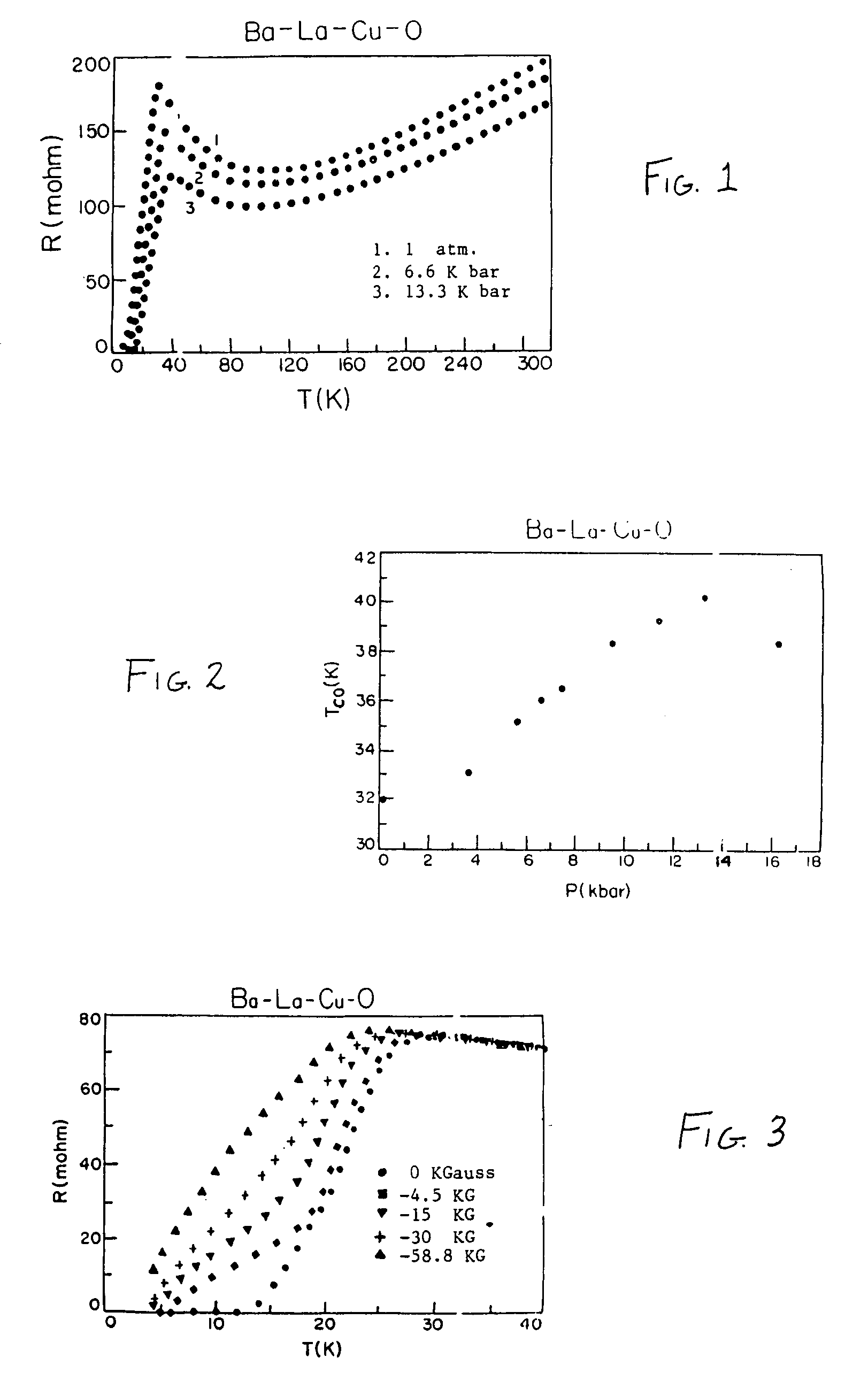Superconductivity in square-planar compound systems
a compound system and square-planar technology, applied in the field of superconducting compositions, can solve the problem that the superconductivity of a material occurs only at very low temperatures, and achieve the effects of reducing interatomic spacing, enhancing the transition temperature to higher limits, and reducing interatomic spacing
- Summary
- Abstract
- Description
- Claims
- Application Information
AI Technical Summary
Benefits of technology
Problems solved by technology
Method used
Image
Examples
example i
[0056]6.0 grams of La2O3, 0.61 grams of SrCO3 and 1.63 grams of CuO were mixed in ajar mill for about 12 hours. The mixture was then heated at a rate of about 10° C. per minute in air at 1 atmosphere pressure, until it reached a temperature of about 720° C. The mixture was then allowed to react for about an hour at about 720° C. After this reaction step, the temperature was raised to a temperature of about 1000° C. at a rate of about 30° C. per minute. Once at a 1000° C. temperature, the samples were maintained at this temperature for about twenty-one hours. This allowed the completion of a solid state reaction. After cooling to room temperature, the reacted mixture was pulverized in a jar mill for about 6 hours until the sample was homogenized. The pulverized mixture was then heated rapidly to a temperature of about 1000° C., and kept at that temperature for about seven hours. After this period, the mixture was cooled to room temperature and then compressed under a pressure of six ...
example ii
[0058]6.0 grams of La2O3, 0.61 grams of SrCO3 and 1.63 grams of CuO were mixed mechanically in a jar mill for approximately 24 hours. The resulting mixture was then compressed into pellets by applying a pressure of about 2 kilobars. The pellets were heated to about 1000° C., and allowed to react for about twenty-four hours in air. The reacted pellets were then quenched rapidly to room temperature.
[0059]The La—Sr—Cu—O composition produced from this process had a formula of La1.8Sr0.2Cu1Oy. This corresponds to an oxide complex of the general formula [La1−xSrx]aCubOy wherein “x” is 0.1, “a” is 2, “b” is 1 and “y” is 2 to 4. This composition showed superconductive properties at a temperature of about 42°K, with a narrow transition width of about 6°K at ambient pressure.
example iii
[0060]6.0 grams of La2O3, 0.81 grams of BaCO3 and 1.63 grams of CuO were mixed in a mortar-pestle apparatus for about 3 hours. The mixture was then heated at a rate of about 10° C. per minute in oxygen at a pressure of about 2000 microns Hg, until it reached a temperature of 720° C. The mixture was then allowed to react for about an hour at about 720° C. After this reaction, the temperature was raised to a temperature of about 950° C., this raise in temperature was made at a rate of about 30° C. per minute. Once at this temperature, the sample was maintained at this temperature for about twenty-one hours. After this period, the sample was cooled to room temperature and then the reacted mixture was pulverized until the sample was homogenized. The pulverized mixture was then heated rapidly to a temperature of about 950° C., and kept at that temperature for about seven hours. After this period, the sample was again cooled to room temperature and the mixture was compressed under a press...
PUM
| Property | Measurement | Unit |
|---|---|---|
| pressure | aaaaa | aaaaa |
| temperature | aaaaa | aaaaa |
| pressure | aaaaa | aaaaa |
Abstract
Description
Claims
Application Information
 Login to View More
Login to View More - R&D
- Intellectual Property
- Life Sciences
- Materials
- Tech Scout
- Unparalleled Data Quality
- Higher Quality Content
- 60% Fewer Hallucinations
Browse by: Latest US Patents, China's latest patents, Technical Efficacy Thesaurus, Application Domain, Technology Topic, Popular Technical Reports.
© 2025 PatSnap. All rights reserved.Legal|Privacy policy|Modern Slavery Act Transparency Statement|Sitemap|About US| Contact US: help@patsnap.com



